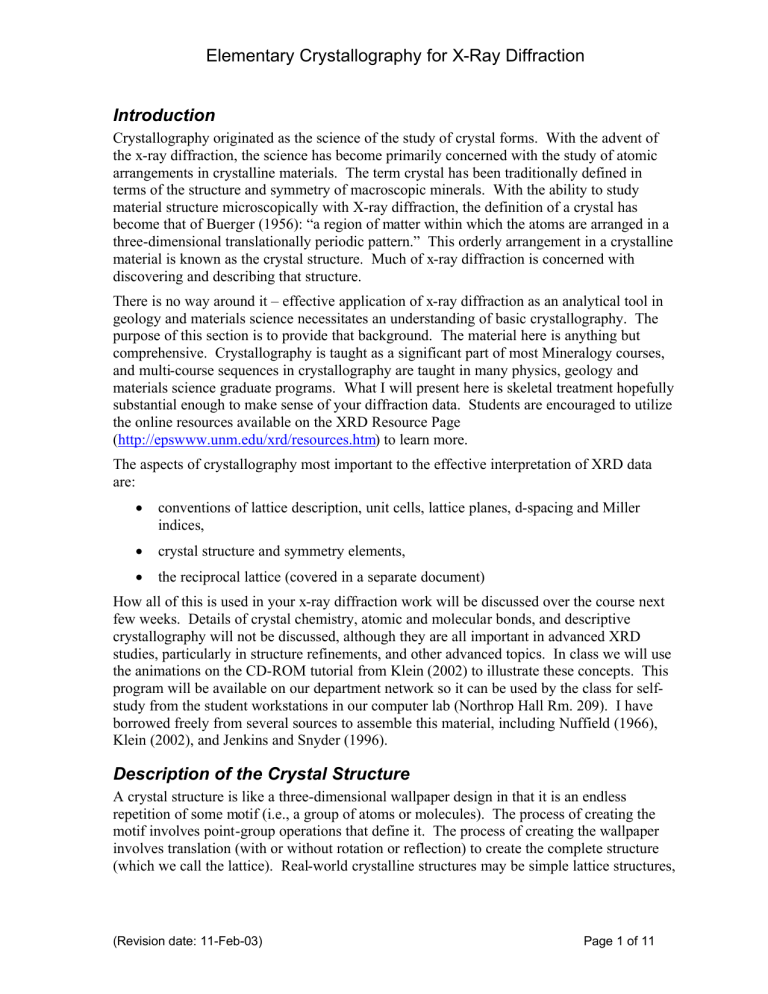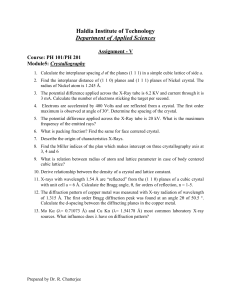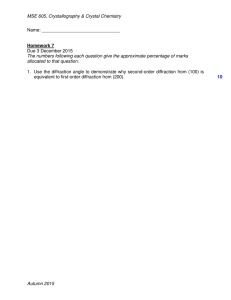04-crystalography-for-xrd

Elementary Crystallography for X-Ray Diffraction
Introduction
Crystallography originated as the science of the study of crystal forms. With the advent of the x-ray diffraction, the science has become primarily concerned with the study of atomic arrangements in crystalline materials. The term crystal has been traditionally defined in terms of the structure and symmetry of macroscopic minerals. With the ability to study material structure microscopically with X-ray diffraction, the definition of a crystal has become that of Buerger (1956): “a region of matter within which the atoms are arranged in a three-dimensional translationally periodic pattern.” This orderly arrangement in a crystalline material is known as the crystal structure. Much of x-ray diffraction is concerned with discovering and describing that structure.
There is no way around it – effective application of x-ray diffraction as an analytical tool in geology and materials science necessitates an understanding of basic crystallography. The purpose of this section is to provide that background. The material here is anything but comprehensive. Crystallography is taught as a significant part of most Mineralogy courses, and multi-course sequences in crystallography are taught in many physics, geology and materials science graduate programs. What I will present here is skeletal treatment hopefully substantial enough to make sense of your diffraction data. Students are encouraged to utilize the online resources available on the XRD Resource Page
( http://epswww.unm.edu/xrd/resources.htm
) to learn more.
The aspects of crystallography most important to the effective interpretation of XRD data are:
• conventions of lattice description, unit cells, lattice planes, d-spacing and Miller indices,
• crystal structure and symmetry elements,
• the reciprocal lattice (covered in a separate document)
How all of this is used in your x-ray diffraction work will be discussed over the course next few weeks. Details of crystal chemistry, atomic and molecular bonds, and descriptive crystallography will not be discussed, although they are all important in advanced XRD studies, particularly in structure refinements, and other advanced topics. In class we will use the animations on the CD-ROM tutorial from Klein (2002) to illustrate these concepts. This program will be available on our department network so it can be used by the class for selfstudy from the student workstations in our computer lab (Northrop Hall Rm. 209). I have borrowed freely from several sources to assemble this material, including Nuffield (1966),
Klein (2002), and Jenkins and Snyder (1996).
Description of the Crystal Structure
A crystal structure is like a three-dimensional wallpaper design in that it is an endless repetition of some motif (i.e., a group of atoms or molecules). The process of creating the motif involves point-group operations that define it. The process of creating the wallpaper involves translation (with or without rotation or reflection) to create the complete structure
(which we call the lattice). Real-world crystalline structures may be simple lattice structures,
(Revision date: 11-Feb-03) Page 1 of 11
Elementary Crystallography for X-Ray Diffraction or combinations of lattices to make complex crystalline molecules. As long as the structure is repetitive, its structure may be discovered with the application of x-ray diffraction.
Lattice Notation
Klein (2002) defines a lattice as “an imaginary pattern of points (or nodes) in which every point (node) has an environment that is identical to that of any other point (node) in the pattern. A lattice has no specific origin, as it can be shifted parallel to itself.”
The figure at left (Fig 1-5) shows method of notating lattice points, rows, and planes on the basis of the crystal coordinate systems. A point in the lattice is chosen at the origin and defined as 000. The a , b and c axes define the directions within the crystal structure with the angular relations defined by the particular crystal system.
Lattice points are specified without brackets –
100, 101, 102, etc. 100 is thus a point one unit along the a axis, 002 is a point two units along the c axis, and 101 is a point one unit from a and one unit from c .
Lattice planes are defined in terms of the Miller indices , which are the reciprocals of the intercepts of the planes on the coordinate axes. In Fig. 1-5, the plane shown intercepts a at
100, b at 010 and c at 002. The Miller index of the plane is thus calculated as 1/1( a ),
1/1( b ), 1/2( c ), and reduced to integers as
2 a ,2 b ,1 c . Miller indices are by convention given in parentheses, i.e., (221). If the calculations result in indices with a common factor (i.e., (442)) the index is reduced to the simplest set of integers (221). This means that a Miller index refers to a family of parallel lattice planes defined by a fixed translation distance (defined as d ) in a direction perpendicular to the plane. If directions are negative along the lattice, a bar is placed over the negative direction, i.e. (2 2 1)
Families of planes related by the symmetry of the crystal system are enclosed in braces { }.
Thus, in the tetragonal system {110} refers to the four planes (110), ( 1 10), ( 1 1 0) and
(1 1 0). Because of the high symmetry in the cubic system, {110} refers to twelve planes. As an exercise, write the Miller indices of all of these planes.
Spacing of Lattice Planes: The perpendicular distance separating each lattice plane in a stack is denoted by the letter d . Figure 1-7 shows several lattice planes and the associated d
(Revision date: 11-Feb-03) Page 2 of 11
Elementary Crystallography for X-Ray Diffraction spacings. In a and c are in the plane of the paper, and b is perpendicular to the plane of the page. The notation shown for the d spacing and the relationship to the particular lattice plane
(i.e., d
001
, d
101
, d
103
) with the Miller index for the particular plane shown in the subscript (but usually without parentheses) are standard notation used in crystallography and x-ray diffraction.
The values of d spacings in terms of the geometry of the different crystal systems are shown in Table 1-2 below (from Nuffield, 1966). The crystal systems (discussed in the next section) are listed in order of decreasing symmetry. The calculations are increasingly complex as symmetry decreases. Crystal structure calculations are relatively simple for the cubic system, and can be done with a good calculator for the tetragonal and orthorhombic system. In actual practice, these calculations are usually done with the aid of specialized computer programs specifically written for this purpose.
Symmetry
In X-ray diffraction we make use of the repetition of the arrangement of atoms (or motif) in a crystal structure. The repetition produces the diffraction pattern. If there is no repetition, as
(Revision date: 11-Feb-03) Page 3 of 11
Elementary Crystallography for X-Ray Diffraction there is for truly amorphous materials, there is no diffraction pattern. Repetition of the motif in a lattice defines its symmetry.
Basically, a symmetry operation may be thought of as moving a shape-object in such a way that after the movement, the object appears exactly the same as it did before the movement.
An alternative way to view symmetry is as a series of replication operations on one surface of a shape-object by which the entire object may be generated. Crystal structures are defined based on the symmetry operations used to replicate (or create) the structure.
All symmetry operations may be defined by several basic movement operations. These are described below:
Rotation (Symbols used: 1,2,3,4,6 for rotation with number of “repeats” of the form during one 360
°
rotation. As an example, in 4-fold rotation, it takes four rotational movements of the form to return to the original position, and the form is identically repeated at each of the four rotational stages.)
Reflection (Symbol used: m . Form is replicated by mirror reflection across a plane.)
Inversion (Symbol used: i . Form is replicated by projection of all points through a point of inversion; this defines a center of symmetry.)
Rotation-Inversion (Symbol used: 1 for single rotation/inversion. May be combined with rotational operations, i.e., 3 = 3-fold rotation w. inversions at each rotation.)
Translation (A lateral movement which replicates the form along a linear axis)
In general, rotation, reflection and inversion operations generate a variety of unique arrangements of lattice points in three dimensions. These translation-free symmetry operations are called point-group elements.
Translations are used to generate a lattice from that shape structure. The translations include a simple linear translation, a linear translation combined with mirror operation (glide plane), or a translation combined with a rotational operation (screw axis). A large number of 3dimensional structures (the 230 Space Groups) are generated by these translations acting on the 32 point groups as discussed in the next section.
The repetitive nature of crystal structures results in the presence of stacks planar arrays of atoms. Repeating, equidistant planar elements (d-spacings) are present in all crystals. The measurement of these d-spacings and the variations in intensity of the diffractions caused by them can be used to uniquely “fingerprint” the crystal studied. This is the basis of x-ray crystallography.
Classification and Crystal Structure
The repetition of the atomic-molecular motif in a lattice is what defines the crystal structure.
This section begins with the five possible planar lattices, the Bravais lattices developed from them in three dimensions, the point-groups derived by non-translation symmetry operations, and the 230 possible space groups derived by translations of the point groups. The development is, at best, incomplete. For a more comprehensive discussion, the reader is referred to Klein (2002) or Nuffield (1966). For a detailed and rigorous treatment, the reader
(Revision date: 11-Feb-03) Page 4 of 11
Elementary Crystallography for X-Ray Diffraction is referred to Donald Bloss (1971) “Crystallography and Crystal Chemistry: An
Introduction” .
Lattices and Crystal Systems
There are five planar translation lattices, shown in Fig. 1-3 (from Nuffield, 1966).
When translated in three dimensions, the plane lattices define an assemblage of points in space. By selection of different groups of points in two dimensions, and “copying” that group in the third dimension, we can produce the fourteen space lattices shown on the following page (Fig. 5.65 from Klein, 2002). These lattices are called the Bravais lattices after Auguste Bravais (1811-1863) who was the first to show that they were unique. The
CD-ROM tutorial (Klein, 2002) includes an animated derivation of ten of the fourteen space lattices from the plane lattices (Module 3 – Generation of 10 Bravais lattices).
The six crystal systems (table below) are defined by relationships between unit cell edge lengths and the angles between those edges. The combination of centering and relationship between the angles between lattice directions and axis length define the 14 lattice types within the 6 crystal systems. In the primitive lattice (P) all atoms in the lattice are at the corners. In the body centered lattices (I) there is an additional atom at the center of the lattice. There are two types of face centering, one in which the atoms are centered on a pair of opposing plane lattices (C) and another in which an atom is centered on each face (F). It is important to note that the choice of the planar replication unit and the direction of that replication in three dimensions that determines the character of the lattice.
System
Triclinic P
Type
Monoclinic
Orthorhombic
Tetragonal
P (b = twofold axis)
C
P (c = twofold axis)
C
P
C (or A, B)
I
F
P
I
Edge - Angle Relations Symmetry a
≠
b
≠
c
α ≠ β ≠ γ a
≠
b
≠
c
α
=
γ
= 90
° ≠ β a
≠
b
≠
c
α ≠ β
= 90
° ≠ γ
I
2/m a
≠
b
≠
c
α
=
β
=
γ
= 90
° mmm a
1
= a
2
≠
c
α
=
β
=
γ
= 90
°
4/mmm
(Revision date: 11-Feb-03) Page 5 of 11
System
Hexagonal
Cubic
Elementary Crystallography for X-Ray Diffraction
Type
R
P
P
I
F
Edge - Angle Relations Symmetry a
1
= a
2
≠
c
α
=
β
= 90
°
,
γ
= 120
°
3 m
6/mmm a
1
= a
2
= a
3
α
=
β
=
γ
= 90
° m3m
(Revision date: 11-Feb-03) Page 6 of 11
Elementary Crystallography for X-Ray Diffraction
Table 5.9 from Klein, 2002 (below) presents another way of cross-referencing the distribution of the 14 Bravais Lattices among the six crystal systems that the reader might find helpful.
Figure 1-8 (from Nuffield, 1966) below describes diagrammatically (as spherical projections) the translation-free symmetry operations by which the 32 point-groups are generated from the 14 Bravais lattices. On the diagrams small dots represent upper hemisphere projections, open circles represent lower hemisphere projections. The upper row shows mirror operations
( m ), the middle row shows 1-fold through 6-fold rotational operations ( 1 , 2 , 3 , 4 , 6 ), and the bottom row shows rotation-inversion operations ( 1 , 2 , 3 , 4 , 6 ).
(Revision date: 11-Feb-03) Page 7 of 11
Elementary Crystallography for X-Ray Diffraction
Note that 1 and 1 represent the lowest symmetry conditions, 1-fold rotation and simple centrosymmetry (inversion through a center), respectively; this is the only symmetry in the triclinic system. It is also noted that 2 is exactly equivalent to the mirror condition where the mirror plane is parallel with the page surface (found in the monoclinic system).
(Revision date: 11-Feb-03) Page 8 of 11
Elementary Crystallography for X-Ray Diffraction
Table 5.5 from Klein (2002) on the following page summarizes (and explains) the crystal classes as defined by their symmetry elements, including the standardized Herrmann-
Mauguin notation used in crystallographic notation. Some notation conventions:
• numbers indicate rotations (2-fold, 4-fold, etc.)
• multiple numbers indicate multiple rotations (usually parallel with axes; in higher symmetry systems rotations are around other symmetry directions)
• m indicates a mirror planes (multiple m = multiple mirror planes)
•
/m following a number indicates rotation perpendicular to a mirror plane
•
A bar over a number indicates a rotoinversion
•
P (primitive), F (face centered), I (body centered), R (rhombohedral primitive), and side centered (A,B, or C) lattice types used with Space Group notation (Table 5.10)
(Revision date: 11-Feb-03) Page 9 of 11
Elementary Crystallography for X-Ray Diffraction
Translation Operations
Direct translation is clearly enables the point group symmetry elements to replicate into a macroscopic crystalline structure. Without a rotational component, translation is not capable of adding unique symmetry to the structure and thus does not effect the variations which produce the Space Groups. Translational symmetry operations acting on the Bravais lattices and point groups produce the 230 Space Groups (see Table 5.10 from Klein, 2002 for all the space group symbols and the associated crystal classes). The translational symmetry operations are:
Screw-axis: rotation about an axis combined with translation parallel to the axis. Screw axes are restricted by the translational periodicity of the crystals to repetitions at angular intervals of 180, 120, 90, and 60
°
, defining 2-fold, 3-fold, 4-fold and 6-fold axes, respectively. The subscript notation indicates the fraction of the total translation distance covered by one screw operation, i.e. 4
1
indicates 4-fold screw operation with ¼ the translation increment. 4
2 indicates 4-fold screw operation of a motif pair with ½ the translation increment.
Glide Plane: reflection across a plane combined with translation parallel to the plane. Glides are expressed as a/2 , b/2 , or c/2 (increment x ½) when the glide is parallel to a crystallographic axis and the motif is repeated twice during in one translation increment. If the denominator is 4 (x ¼), the motif repeats 4 times during the increment. Diagonal glides occur bisecting axis directions. Types are the diagonal (n) when the repeat increment is 2 or diamond (d) when the repeat increment is 4.
We will use Klein’s (2002) CD-ROM tutorial material to demonstrate screw-axis and glide plane operations in class.
(Revision date: 11-Feb-03) Page 10 of 11
Elementary Crystallography for X-Ray Diffraction
(Revision date: 11-Feb-03) Page 11 of 11


